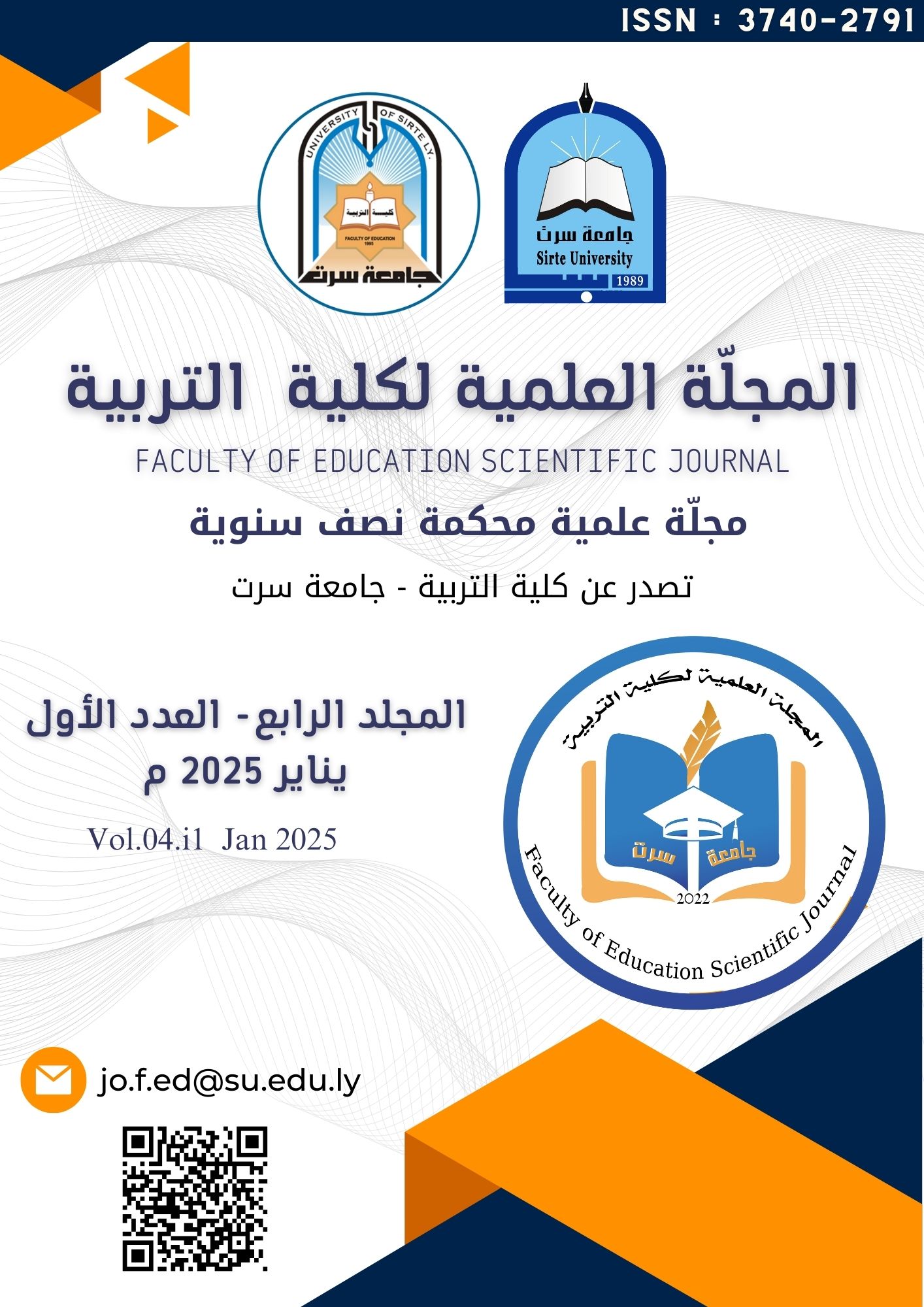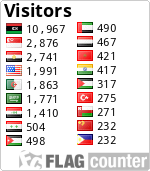Cybersecurity Awareness among College Students in Libyan Universities last
DOI:
https://doi.org/10.37375/foej.v4i1.3152الكلمات المفتاحية:
الوعي بالأمن السيبراني، الجامعات الليبية، الجرائم الالكترونية، امن المعلوماتالملخص
ينصب التركيز في الآونة الأخيرة على الأمن السيبراني الذي يشكل مصدراً متزايداً للقلق في جميع أنحاء العالم نتيجة للتطور في الثورة الرقمية التي حولت الإنترنت إلى أرض خصبة لمجرمي الإنترنت. حيث يؤكد العدد المتزايد من الجرائم الإلكترونية على أهمية رفع مستوى الوعي وتوفير التعليم حول الأمن السيبراني للأفراد والشركات. تستكشف هذه الدراسة تأثير المعرفة بالأمن السيبراني، أمان كلمة المرور والإدراك الذاتي للمهارة على الوعي بالأمن السيبراني بين الطلبة في الجامعات الليبية. تم تجميع عينة من 480 طالبًا جامعيًا من أربع جامعات ليبية عامة. تم إجراء التحليل الكمي للبيانات باستخدام Smart PLS-SEM 3.3.9، اظهرت النتائج وجود ارتباط إيجابي بين المعرفة بالأمن السيبراني، أمان كلمة المرور والإدراك الذاتي للمهارة والوعي بالأمن السيبراني. يوصي هذا البحث أنه يجب زيادة التركيز على تثقيف عامة الناس، وخاصة فئة الطلبة حول الأمن السيبراني وممارسات الإنترنت الأخلاقية. علاوة على ذلك، فإن التركيز الأساسي لهذا البحث هو تسليط الضوء على أهمية الزيادة في تعليم الأمن السيبراني لفئة الطلبة.
المراجع
Agarwal, P., Josh, C. J. I. J. o. M., & Management, F. (2016). E-banking Service Quality Parameters‟ Impact on Customer Satisfaction. 4(2), 01-10.
Ahmed, N., Islam, M. R., Kulsum, U., Islam, M. R., Haque, M. E., & Rahman, M. S. (2019). Demographic factors of cybersecurity awareness in Bangladesh. Paper presented at the 2019 5th International Conference on Advances in Electrical Engineering (ICAEE).
Al-Janabi, S., & Al-Shourbaji, I. (2016). A study of cyber security awareness in educational environment in the middle east. Journal of Information Knowledge Management, 15(01), 1650007.
Al Shamsi, A. A. J. I. J. I. T. L. S. (2019). Effectiveness of cyber security awareness program for young children: A case study in UAE. 3(2), 8-29.
Alharbi, T., & Tassaddiq, A. (2021). Assessment of cybersecurity awareness among students of Majmaah University. Big Data Cognitive Computing, 5(2), 23.
Annansingh, F., Veli, T. J. I. t., & education, s. (2016). An investigation into risks awareness and e-safety needs of children on the internet: a study of Devon, UK. 13(2), 147-165.
Aurigemma, S., & Panko, R. (2012). A composite framework for behavioral compliance with information security policies. Paper presented at the 2012 45th Hawaii International Conference on System Sciences.
Bagozzi, R. P., & Yi, Y. J. J. o. t. a. o. m. s. (1988). On the evaluation of structural equation models. 16, 74-94.
Catal, C., Ozcan, A., Donmez, E., & Kasif, A. (2023). Analysis of cyber security knowledge gaps based on cyber security body of knowledge. Education Information Technologies, 28(2), 1809-1831.
Chandarman, R., & Van Niekerk, B. (2017). Students' cybersecurity awareness at a private tertiary educational institution. The African Journal of Information Communication, 20, 133-155.
Chin, W. W. J. M. q. (1998). Commentary: Issues and opinion on structural equation modeling. In (pp. vii-xvi): JSTOR.
Corallo, A., Lazoi, M., Lezzi, M., & Luperto, A. J. C. i. I. (2022). Cybersecurity awareness in the context of the Industrial Internet of Things: A systematic literature review. 137, 103614.
Cuthbertson, A. J. N., September. (2017). Ransomware attacks rise 250 percent in 2017, Hitting US Hardest. 28, 2017.
Fornell, C., & Larcker, D. F. J. J. o. m. r. (1981). Evaluating structural equation models with unobservable variables and measurement error. 18(1), 39-50.
Hair Jr, J. F., Sarstedt, M., Hopkins, L., & Kuppelwieser, V. G. J. E. b. r. (2014). Partial least squares structural equation modeling (PLS-SEM): An emerging tool in business research. 26(2), 106-121.
Hartwig, K., & Reuter, C. (2022). Nudging users towards better security decisions in password creation using whitebox-based multidimensional visualisations. Behaviour Information Technology, 41(7), 1357-1380.
Henseler, J., Fassott, G., Aluja, T., Casanovas, J., Esposito Vinzi, V. J. P., & Methods, R. (2005). Article in monograph or in proceedings PLS’05. 371-377.
Herbst, T. H. J. S. J. o. I. P. (2020). Gender differences in self-perception accuracy: The confidence gap and women leaders’ underrepresentation in academia. 46(1), 1-8.
Ihmouda, R., & Alwi, N. H. M. (2014). E-government development models: Review of social-technical security aspects. Paper presented at the International conference on Intelligent Systems, Data Mining and Information Technology.
Ihmouda, R., Alwi, N. H. M., & Abdullah, I. (2015). Successful factors on e-government security social-technical aspect.
Ismailova, R., & Muhametjanova, G. J. I. S. J. A. G. P. (2016). Cyber crime risk awareness in Kyrgyz Republic. 25(1-3), 32-38.
Jeske, D., & Van Schaik, P. (2017). Familiarity with Internet threats: Beyond awareness. Computers Security, 66, 129-141.
Junior, C. R., Becker, I., & Johnson, S. J. a. p. a. (2023). Unaware, Unfunded and Uneducated: A Systematic Review of SME Cybersecurity.
Kaloudi, N., & Li, J. J. A. C. S. (2020). The ai-based cyber threat landscape: A survey. 53(1), 1-34.
Karim, A. A., Shah, P. M., Khalid, F., Ahmad, M., & Din, R. J. C. E. (2015). The role of personal learning orientations and goals in Students’ application of information skills in Malaysia. 6(18), 2002-2012.
kaspersky. (2024). What is cybersecurity? Retrieved from https://www.kaspersky.com/resource-center/definitions/what-is-cyber-security
Khalid, F. (2017). Understanding university students ‘use of Facebook for collaborative learning. International Journal of Information
Education Technology, 7(8), 595-600.
Kim, E. B. (2014). Recommendations for information security awareness training for college students. Information Management Computer Security, 22(1), 115-126.
Kim, L. (2018). Cybersecurity matters. Nursing management, 49(2), 16-22.
Kirwan, G. H., Fullwood, C., & Rooney, B. (2018). Risk factors for social networking site scam victimization among Malaysian students. Cyberpsychology, Behavior, Social Networking, 21(2), 123-128.
Kritzinger, E., Bada, M., & Nurse, J. R. (2017). A study into the cybersecurity awareness initiatives for school learners in South Africa and the UK. Paper presented at the Information Security Education for a Global Digital Society: 10th IFIP WG 11.8 World Conference, WISE 10, Rome, Italy, May 29-31, 2017, Proceedings 10.
Kritzinger, E., & von Solms, S. H. (2010). Cyber security for home users: A new way of protection through awareness enforcement. Computers Security, 29(8), 840-847.
Kruger, H., Drevin, L., & Steyn, T. (2010). A vocabulary test to assess information security awareness. Information Management Computer Security, 18(5), 316-327.
Kshetri, N. J. J. o. G. I. T. M. (2019). Cybercrime and cybersecurity in Africa. In (Vol. 22, pp. 77-81): Taylor & Francis.
Ktoridou, D., Eteokleous, N., & Zahariadou, A. J. C.-w. i. s. (2012). Exploring parents’ and children's awareness on internet threats in relation to internet safety. 29(3), 133-143.
Li, N., Tsigkanos, C., Jin, Z., Hu, Z., Ghezzi, C. J. J. o. S., & Software. (2020). Early validation of cyber–physical space systems via multi-concerns integration. 170, 110742.
Manke, S., & Winkler, I. J. S., Retrieved April. (2013). The habits of highly successful security awareness programs: A cross-company comparison. 12, 2016.
Moallem, A. (2019). Cybersecurity awareness among students and faculty: CRC Press.
Muniandy, L., & Muniandy, B. (2012). State of cyber security and the factors governing its protection in Malaysia. International Journal of Applied Science, 2(4), 106-112.
Othman, N. A., Alamsyah, D. P., Rustine, M., Aryanto, R., & Setyawati, I. (2021). ICT and Consumer Behavior: A Study of Students’ Self-Perceived Digital. Paper presented at the 2021 International Seminar on Intelligent Technology and Its Applications (ISITIA).
Pogrebna, G., & Skilton, M. (2019). Navigating new cyber risks: Springer.
Rahim, N. H. A., Hamid, S., & Kiah, L. M. J. M. J. o. C. S. (2019). ENHANCEMENT OF CYBERSECURITY AWARENESS PROGRAM ON PERSONAL DATA PROTECTION AMONG YOUNGSTERS IN MALAYSIA: AN ASSESSMENT. 32(3).
Ratten, V. (2015). A cross-cultural comparison of online behavioural advertising knowledge, online privacy concerns and social networking using the technology acceptance model and social cognitive theory. Journal of Science Technology Policy Management, 6(1), 25-36.
SANS. (2017). Retrieved from https://securingthehuman.sans.org/media/resources/STHSecurityAwarenessReport-
Senthilkumar, K., & Easwaramoorthy, S. (2017). A Survey on Cyber Security awareness among college students in Tamil Nadu. Paper presented at the IOP Conference Series: Materials Science and Engineering.
Sezer, B., Yilmaz, R., & Karaoglan Yilmaz, F. G. J. I. R. (2015). Cyber bullying and teachers’ awareness. 25(4), 674-687.
Singh, I., & Singh, Y. (2022). Cyber-security knowledge and practice of nurses in private hospitals in northern Durban, kwazulu-Natal. Journal of Theoretical Applied Information Technology, 100(1), 246-267.
Suryotrisongko, H., & Musashi, Y. (2019). Review of cybersecurity research topics, taxonomy and challenges: Interdisciplinary perspective. Paper presented at the 2019 IEEE 12th conference on service-oriented computing and applications (SOCA).
Szumski, O. J. P. C. S. (2018). Cybersecurity best practices among Polish students. 126, 1271-1280.
usaid, T. U. S. A. f. I. D. (2024). Retrieved from https://idea.usaid.gov/cd/libya/information-and-communications-technology-ict
Venter, I. M., Blignaut, R. J., Renaud, K., & Venter, M. A. J. H. (2019). Cyber security education is as essential as “the three R's”. 5(12).
Wang, D., Wang, P., He, D., & Tian, Y. (2019). Birthday, name and bifacial-security: understanding passwords of Chinese web users. Paper presented at the 28th USENIX security symposium (USENIX security 19).
Yıldırım, M., & Mackie, I. J. I. J. o. I. S. (2019). Encouraging users to improve password security and memorability. 18, 741-759.
Zwilling, M., Klien, G., Lesjak, D., Wiechetek, Ł., Cetin, F., & Basim, H. N. J. J. o. C. I. S. (2022). Cyber security awareness, knowledge and behavior: A comparative study. 62(1), 82-97.











